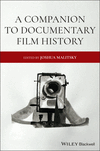Unmanned Capture
Automatic Cameras and Lifeless Subjects in Contemporary Documentary
Joshua Malitsky
Search for more papers by this authorSummary
This chapter focuses on processes of unmanning in contemporary documentary culture. Drawing upon the language of drones (unmanned aerial vehicles or UAV) and computational models of tracking (the "capture model"), it examines authoring agencies in contexts where cameras are focused on human worlds, but for which there is no identifiable camera operator or lively subject. In addition to pervasive automatic cameras and lifeless subjects, the example signals yet another register of unmanned encounter. In unmanned capture, not only is the representational power described by Parenti, via Moten and Harney, maintained, but it is expanded and enriched by computational processes that shape everyday protocols and sites, rendering the experience of who is in the world, and who falls away. Unmanned capture demonstrates the intensification of gatekeeping – as a real time calculative background and the emplacement of grammars of actions – in the production of knowledge and affects.
References
- About the Black Lives Matter Network. (n.d.). Black Lives Matter's Official Website . [online] http://blacklivesmatter.com/about (accessed 12 July 2017).
- Agre, P. (2003). Surveillance and Capture: Two Models of Privacy. In: The New Media Reader (eds. N. Wardrip-Fruin and N. Monfort), 737–759. Cambridge, MA: MIT Press.
- Almukhtar, S., et al. (2016). The Keith Scott Shooting: A 3-D Reconstruction. New York Times, [online] 13 October. https://www.nytimes.com/interactive/2016/09/25/us/charlotte-scott-shooting-video.html (Accessed 12 July 2017).
- Apuzzo, M. and Eligon, J. (2015). Ferguson Police Tainted by Bias, Justice Department Says. New York Times, [online] 4 March. https://www.nytimes.com/2015/03/05/us/us-calls-on-ferguson-to-overhaul-criminal-justice-system.html (accessed 12 July 2017).
- As it Happens . (2015). Some Drivers in China are Intentionally Killing Injured Pedestrians. CBC Radio, [radio] 7 September. http://www.cbc.ca/radio/asithappens/as-it-happens-monday-edition-1.3218166/some-drivers-in-china-are-intentionally-killing-injured-pedestrians-1.3218168 (accessed 12 July 2017).
- Associated Press. (2015). Holder's Report Describes Racial Tension [video]. New York Times [online] 4 March. https://www.nytimes.com/video/us/100000003551245/holders-report-describes-racial-tension.html?searchResultPosition=1 (accessed 12 July 2017).
- Balázs, B. (1970). Theory of Film: Character and Growth of a New Art (trans. E. Bone). London: Dennis Dobson LTD.
- Balsom, E. (2017). The Reality-based Community. e-flux, [online] Volume 83.http://www.e-flux.com/journal/83/142332/the-reality-based-community (accessed 12 July 2017).
- Browne, S. (2015). Dark Matter: On the Surveillance of Blackness. Durham, NC: Duke University Press.
- Cavallaro, J., Sonnenberg, S., and Kunckey, S. (2012). Living Under Drones: Death, Injury and Trauma to Civilians from US Drone Practices in Pakistan. New York: International Human Rights and Conflict Resolution Clinic (Stanford Law School) and Global Justice Clinic (NYU School of Law).
- Cavarero, A. (2009). Horrorism: Naming Contemporary Violence (trans. W. McCuaig). New York: Columbia University Press.
-
Chow, R. (2012). Entanglements, or Transmedial Thinking about Capture. Durham, NC: Duke University Press.
10.1215/9780822395263 Google Scholar
- CNN Wire Staff. (2011). China Hails Woman Who Rescued Bleeding Toddler Left for Dead. [online] CNN. http://www.cnn.com/2011/10/19/world/asia/china-toddler-rescued/index.html (accessed 12 July 2017).
- Crary, J. (1990). Techniques of the Observer: On Vision and Modernity in the Nineteenth Century. Cambridge, MA: MIT Press.
- Dao, J. (2013). Drone Pilots Are Found to Get Stress Disorders Much as Those in Combat Do. New York Times, [online] 22 February.http://www.nytimes.com/2013/02/23/us/drone-pilots-found-to-get-stress-disorders-much-as-those-in-combat-do.html (accessed 12 July 2017).
-
Deleuze, G. (1986). Cinema 1: The Movement-Image (trans. H. Tomlinson and B. Habberjam). Minneapolis, MN: University of Minnesota Press.
10.5040/9781350251977 Google Scholar
- Deleuze, G. (1995). Negotiations: 1972–1990 (trans. M. Joughin). New York: Columbia University Press.
-
van Dijck, J. and Poell, T. (2013). Understanding Social Media Logic. Media and Communication
1 (1): 2–14.
10.17645/mac.v1i1.70 Google Scholar
- Fausset, R. and Blinder, A. (2016). Charlotte Officer “Justified” in Fatal Shooting of Keith Scott. New York Times, [online] 30 November.https://www.nytimes.com/2016/11/30/us/charlotte-officer-acted-lawfully-in-fatal-shooting-of-keith-scott.html (accessed 12 July 2017).
- Fiske, J. (2002). Videotech. In: The Visual Culture Reader (ed. N. Mirzoeff), 383–391. New York: Routledge.
- Foucault, M. (1977). Discipline and Punish: The Birth of the Prison (trans. A. Sheridan). New York: Vintage Books.
- Foucault, M. (2003). Society Must Be Defended: Lectures at the College de France, 1975–76 (trans. D. Macey). New York: Picador.
- Garvie, C. and Frankle, J. (2016). Facial Recognition Software Might Have a Racial Bias Problem. The Atlantic, [online] 7 April. http://www.theatlantic.com/technology/archive/2016/04/the-underlying-bias-of-facial-recognition-systems/476991 (accessed 12 July 2017).
-
Gates, K. (2011). Our Biometric Future: Facial Recognition and the Culture of Surveillance. New York: New York University Press.
10.18574/nyu/9780814732090.001.0001 Google Scholar
- Gregory, D. (2011). From a View to a Kill: Drones and Late Modern War. Theory, Culture and Society 28 (7–8): 188–215.
- Guo, O. and Ives, M. (2016). A Toddler Dies as Her Mother Checks Her Phone, and China Wrings Its Hands. New York Times, [online] 1 November.http://www.nytimes.com/2016/11/02/world/asia/china-mobile-phone-mother-daughter.html (accessed 12 July 2017).
- He, H. (2013). Shenzhen Introduces Good Samaritan Law. South China Morning Post, [online] 1 August. http://www.scmp.com/news/china/article/1293475/shenzhen-introduces-good-samaritan-law (accessed 12 July 2017).
- Heller-Roazen, D. (2009). The Enemy of All: Piracy and the Law of Nations. New York: Zone Books.
- Huazhong, W. (2010). Drunken Driver Boasts Father Is a Police Official. China Daily, [online] 20 October. www.chinadaily.com.cn/china/2010-10/20/content_11431705.htm (accessed 12 July 2017).
- Kimbriell, K., et al. (2016). Fatal Shootings by Police Remain Relatively Unchanged after Two Years. Washington Post, [online] 30 December. https://www.washingtonpost.com/investigations/fatal-shootings-by-police-remain-relatively-unchanged-after-two-years/2016/12/30/fc807596-c3ca-11e6-9578-0054287507db_story.html?utm_term=.26f5b31426a6 Accessed 12 July 2017).
- Kirschenbaum, M. (2008). Mechanisms: New Media and the Forensic Imagination. Cambridge, MA: MIT Press.
- Lazzarato, M. (2009). Neoliberalism in Action: Inequality, Insecurity and the Reconstitution of the Social. Theory, Culture and Society 26 (6): 109–133.
-
Lyon, D. (2014). Surveillance, Snowden, and Big Data: Capacities, Consequences, Critique. Big Data & Society
1 (2): 1–13.
10.1177/2053951714541861 Google Scholar
-
Mann, S., Nolan, J., and Wellman, B. (2003). Sousveillance: Inventing and Using Wearable Computing Devices for Data Collection in Surveillance Environments. Surveillance and Society
1 (3): 331–355.
10.24908/ss.v1i3.3344 Google Scholar
- Minter, A. (2012). China's Infamous “Good Samaritan” Case Gets a New Ending. Bloomberg, [online] 18 January. https://www.bloomberg.com/view/articles/2012-01-17/china-s-infamous-good-samaritan-case-gets-a-new-ending-adam-minter (accessed 12 Jul 2017).
- Moore, M. (2011). Chinese Hit-and-Run Toddler Dies. The Telegraph, [online] 21 October. www.telegraph.co.uk/news/worldnews/asia/china/8840381/Chinese-girl-run-over-by-a-car-dies.html (accessed 12 July 2017).
- Moten, F. and Harney, S. (2013). The Undercommons: Fugitive Planning & Black Study. New York: Minor Compositions.
- Nichols, B. (1983). The Voice of Documentary. Film Quarterly 36 (3): 17–30.
- Paglen, Trevor (2016). Invisible Images (Your Pictures Are Looking at You). The New Inquiry, [online], 8 December. https://thenewinquiry.com/invisible-images-your-pictures-are-looking-at-you/ (accessed 12 July 2017).
- Sanchez, R. (2017). Obama's Last Airstrike “Kills 100 al-Qaeda Fighters in Syria. The Telegraph, [online] 21 January. https://www.telegraph.co.uk/news/2017/01/21/obamas-last-airstrike-kills-100-al-qaeda-fighters-syria/ (accessed 12 July 2017).
- Sant, G. (2015). Driven to Kill: Why Drivers in China Intentionally Kill the Pedestrians They Hit. Slate, [online] 4 Sept. http://www.slate.com/articles/news_and_politics/foreigners/2015/09/why_drivers_in_china_intentionally_kill_the_pedestrians_they_hit_china_s.html (accessed 12 July 2017).
- Sobchack, V. (2004). Carnal Thoughts: Embodiment and Moving Image Culture. Berkeley, CA: University of California Press.
- Steyerl, H. (2016). A Sea of Data: Apophenia and Pattern (Mis)recognition. e-flux #72, http://www.e-flux.com/journal/72/60480/a-sea-of-data-apophenia-and-pattern-mis-recognition
- Thompson, K. (2010). Drone Porn: The Newest YouTube Hit. World Post, [online]. http://www.huffingtonpost.com/keith-thomson/drone-porn-the-newest-you_b_407083.html (accessed 12 Jul. 2017).
- Thrift, N. (2004). Movement-Space: The Changing Domain of Thinking Resulting from the Development of New Kinds of Spatial Awareness. Economy and Society 33 (4): 582–604.
- Turkle, S. (2011). Alone Together: Why We Expect More from Technology and Less from Each Other. New York: Basic Books.
- Wenfang, L. (2011). Girl in Double Hit-and-Run Dies. China Daily, [online] 22 October. www.chinadaily.com.cn/china/2011-10/22/content_13953890.htm (accessed 12 July 2017).
- Wigoder, M. (2013). The Digitized Death of Colonel Gaddafi and the End of Photography. In: The Versatile Image: Photography, Digital Technologies, and the Internet (eds. A. Moschovi, C. Mckay and A. Plouviez), 53–73. Leuven: Leuven University Press.



